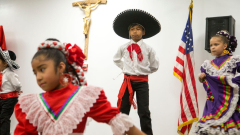
Thursday marks the start of Hispanic Heritage Month, a celebration honoring the contributions and histories of Americans with roots in Spain, Mexico, Central and South America and the Caribbean.
The observance straddles two months, spanning from Sept. 15 through Oct. 15, honoring a long-established community whose influence is felt throughout the country.
“It celebrates a vast community of Americans who have made invaluable contributions to the United States for over 300 years,” said Margie Huerta, executive director of the National Hispanic Cultural Center in Albuquerque. “Hispanic and Latinx people are making important contributions to American arts, culture and humanities, and all aspects of society, every single day.”
Who started Hispanic Heritage Month?
From newly arrived immigrants to native communities that have called these lands home for centuries, it’s a community that has gained considerable cultural and political clout since the occasion began in 1968 as a weeklong commemoration under President Lyndon Johnson. The legislation was sponsored by California U.S. Rep. Edward Roybal of Los Angeles, an Albuquerque native whose family moved to California when he was six.
In 1988, President Ronald Reagan signed into law a bill sponsored by Illinois Sen. Paul Simon expanding National Hispanic Heritage Week to its current 30-day period. Reagan used the moment to praise Hispanics and their cultural pillars of church and school, but most of all to extol the virtues of familia.
Mexican culture in the US: Texas boy is the world’s youngest mariachi. For his dad, it’s a return to Mexican family roots
“As the great poet Octavio Paz has said: ‘In Hispanic morals, the true protagonist is the family,’” Reagan said in his address. “I fear that too often, in the mad rush of modern American life, some people have not learned the great lesson of our Hispanic heritage: the lesson of family and home and church and community.”
How many Hispanics are in the US?
According to July 2021 estimates from the Census Bureau, the United States is home to nearly 63 million Hispanics. It’s a growing population: A Pew Research Center analysis of 3,140 counties – those with Hispanic populations of at least 1,000 in 2010 – found that Hispanics grew 23% from 2010 to 2020, more than three times the national population growth rate of 7%.
Much of that growth is taking place in states without historically large Hispanic populations, the analysis found. In 1990, nine states, including Texas and New York, accounted for 86% of the nation’s Hispanics, but by 2020, that figure had fallen to 73%.
In terms of percentage, the largest rates of growth took place in other states including North Dakota, Louisiana, Georgia and Alabama, where Hispanic populations grew as much as tenfold.
Undocumented Latinos: ‘I don’t know if I will be deported’: Young immigrants prepare for DACA to end
The county with the largest Hispanic population – 4.8 million – remains California’s Los Angeles County. The county with the largest overall growth from 2010 to 2020 was Houston’s Harris County, Texas, where the Hispanic population grew by 363,000.
Why does the celebration span two months?
The month’s starting date of Sept. 15 is significant: It’s the independence day for Costa Rica, El Salvador, Guatemala, Honduras and Nicaragua. And Mexico, Chile and Belize mark their celebrations on Sept. 16, Sept. 18 and Sept. 21.
Starting in the middle of the month also encompasses, on the celebration’s latter end, Oct. 12. Known as Columbus Day in the United States, the day is referred to in Mexico and other Spanish-speaking countries as Día de la Raza, honoring the countries and peoples conquered by Spain and other European nations.
How do you celebrate Hispanic Heritage Month?
Gabriela Baeza Ventura, a professor of Spanish at the University of Houston, said Hispanic Heritage Month pays respect to a population with deep roots in the United States and a wide range of ancestral origins.
“It’s a wonderful and important opportunity for the general public to visualize the contributions and presence of a community that has been in this territory since before the U.S. was formed as a nation,” Ventura said. “It’s a community that encompasses so many different nations, so many registers of




